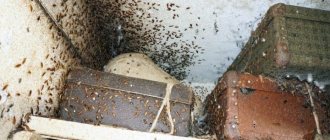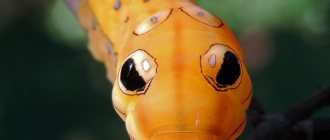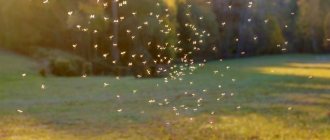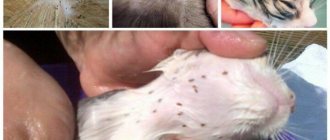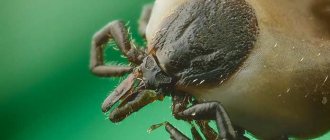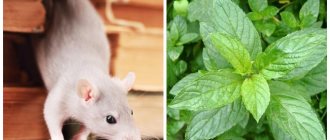- Wild animals
- >>
- Crustaceans
Shrew (Triopsidae) is a genus of small crustaceans from the suborder Notostraca. Some species are considered living fossils, with origins dating back to the end of the Carboniferous period, namely 300 million years ago. Along with horseshoe crabs, shield crabs are the most ancient species. They have lived on Earth since the time of dinosaurs, and have not changed at all since those times, with the exception of decreasing in size. These are the most ancient animals existing today.
Origin of the species and description
Photo: Shchiten
The suborder Notostraca contains one family, Triopsidae, and only two genera, Triops and Lepidurus. By the 1950s, up to 70 species of shield bugs had been discovered. Many putative species are described based on morphological variation. There were two important revisions to the classification of the family - Linder in 1952 and Longhurst in 1955. These revised many of the taxa and defined only 11 species in two genera. This taxonomy was accepted for decades and was considered dogma.
Video: Shchiten
Interesting fact: More recent studies using molecular phylogenetics have demonstrated that the eleven currently recognized species harbor more reproductively isolated populations.
The shieldfish is sometimes called a “living fossil” because fossils belonging to the suborder were discovered in rocks of the Carboniferous period, some 300 million years ago. One extant species, the crustacean T. cancriformis, has remained virtually unchanged since the Jurassic period (about 180 million years ago).
There are many fossils of shieldfish found in a range of geological deposits. The absence of serious morphological changes that occurred in the family over the 250 million years of existence of these animals suggests that dinosaurs also saw shields in this form. Casachartra, an extinct group known only from Triassic and Jurassic fossils from western China and Kazakhstan, is closely related to shieldfishes and may belong to the order Notostraca.
Rare endangered animals of unusual appearance
Large softshell turtle (Pelochelys bibroni)
The large soft-bodied turtle, which belongs to the family of three-clawed turtles, looks as if an ordinary Central Asian turtle had been run over by a roller skating rink. Add here a strange proboscis nose - and you get a very unusual appearance.
Unlike many of its relatives, this species of turtle does not have a hard shell.
. Its carapace (dorsal shield of the shell) is bordered by a cartilaginous border. The shell itself feels like rubber to the touch, as it is covered with soft skin.
The largest representatives of this species can reach two meters in size. These turtles live in fresh water bodies; they prefer rivers with not very strong currents. Spend most of their time in water
, buried in the sand. They come to the surface a couple of times a day to get their share of air.
Indian purple frog (Nasikabatrachus sahyadrensis)
This rare frog is a true living fossil. Its habitat is extremely limited - about 14 square kilometers. Scientists discovered this species relatively recently - in 2003, in the Western Ghats mountains, India.
It was not possible to classify this species for a long time because the Indian purple frog spends the vast majority of its time underground
. In principle, she does not need to get out, since the main part of her food is termites, which she successfully eats there, underground.
In 2008, this frog was included in the list of the ugliest representatives of the animal world on our planet. In many ways, the frog owes this “title” not only to its squat, swollen body, but also to the specific shape of its muzzle
. These frogs can grow up to 9 centimeters in length.
Chinese giant salamander (Andrias davidianus)
The Chinese giant salamander is a unique animal. It belongs to the genus of gigantic salamanders, being the largest amphibian on our planet. It is known that this amphibian can reach a length of 180 centimeters, and its weight reaches 70 kilograms.
However, salamanders of this size are quite rare.
. Salamanders are predators. The typical diet of the Chinese giant salamander includes insects, fish, crabs, frogs and even other salamanders.
15 of the world's rarest animals
The Chinese giant salamander is a critically endangered species. However, more recently, this interesting animal was widespread throughout China. But since the 1950s, the salamander population has been declining sharply.
The reason for the extinction is that humanity is replacing the salamanders
from their usual habitat. In addition, salamanders are destroyed purposefully - the Chinese have long been using this animal in their medicine; salamander meat is considered a delicacy.
Goliath Birdeater
The name of this spider speaks for itself - this arthropod is the largest spider on our planet. Its usual habitat is the tropical rainforests of South Africa and South America.
The largest representative of this species, included in the Guinness Book of Records, was discovered in Venezuela. The size of the record holder is amazing - the span of his legs was close to thirty centimeters
. There is a known species of spider with a large leg span, but it is significantly inferior in body size to the goliath tarantula.
This arachnophobe's nightmare, despite its menacing size, poses virtually no threat to people. But people pose a threat to it: many spider breeders would like to see it in their collections, despite the fact that this species of spider reproduces extremely rarely in captivity.
Appearance and features
Photo: What the shield looks like
Shields are 2–10 cm long, have a wide carapace in the front and a long thin abdomen. This creates an overall tadpole-like shape. The carapace is dorsoventrally flattened and smooth. The front portion includes the head, and two rocky eyes located together on the top of the head. Two pairs of antennas are significantly reduced, and the second pair is sometimes absent altogether. The oral cavities contain a pair of single-branched antennules and no jaws.
Ventral side of the scale, showing up to 70 pairs of legs. The torso contains a large number of "body rings", which look like body segments but do not always reflect the underlying segmentation. The first eleven body rings make up the thorax and bear one pair of legs, each of which also has a genital opening. In the female it is modified, forming a “brood pouch”. The first one or two pairs of legs are distinct from the rest and probably function as sensory organs.
The remaining segments form the abdominal cavity. The number of body rings varies both within and between species, and the number of pairs of legs per body ring can be up to six. The legs gradually become smaller along the abdomen, and in the last segments they are completely absent. The abdomen ends in a telson and a pair of long, thin, multi-jointed caudal branches. The shape of the telson varies between the two genera: in Lepidurus a rounded projection extends between the caudal rami, while in Triops there is no such projection.
Interesting fact: Some species have the ability to turn pink when there is a large amount of hemoglobin in their blood.
The color of shieldweed is often brown or grayish-yellow. On the proximal side of the abdomen, the animal has many small hair-like appendages (about 60) that move rhythmically and allow the individual to direct food towards the mouth. Males and females differ in both size and morphology. Males tend to have a slightly longer carapace length and possess larger secondary antennae that can be used as clamps during breeding. In addition, females have an egg sac.
Now you know what a shield looks like. Let's see where this crustacean lives.
Means and methods of control
In the fight against scale insects and other plant pests, agrotechnical measures are used, including spraying plants with insecticides. To achieve this, work is being carried out in the following directions:
- Development of optimal crop rotation.
- Chemical soil treatment to kill pests.
- Optimization of irrigation systems to prevent moisture stagnation in the fields.
Optimal crop rotation
When planning plantings, it is necessary to exclude sowing the field with rice every season. This culture is worth
alternate with dry grains: oats, corn. Some legumes (soybeans, clover) and buckwheat are also suitable. Before sowing, it is necessary to carry out work aimed at drying out the soil: drainage, creation of furrows and grooves. This will not only get rid of aquatic crustaceans and insects, but also improve the nutritional properties of the soil and create favorable conditions for its saturation with useful elements.
When sowing rice, it is necessary to constantly monitor the water level in the field. During the germination period, it is important to prevent it from rising. Along the edges of the field, as part of phytosanitary treatment, weeds must be pulled out or burned; after harvesting, complete destruction of plant residues is also necessary. If shieldworms are detected, it is recommended to reduce the water level to a minimum for 1-2 days.
Chemical treatment
The following drugs are used as chemical control agents:
- "Simition." It is an organophosphorus intestinal poison directed against a wide range of pests. Consumption per 1 ha is 0.5-1 liter. A 50% emulsion concentrate is used. It is used by spraying the crop.
- "Karate Zeon". Affects arthropods through contact and intestinal means. Recommended for spraying crops during the growing season. 0.15-0.2 liters of solution are spent per 1 hectare.
Correct setup of irrigation systems
For better drainage and irrigation of the soil, it is necessary to use fall plowing, which ensures timely drying of the top layer of soil. The optimal depth is 20-25 cm.
Water supply channels must be promptly cleared of silt and plant debris, which can serve as food for shield bugs. It is recommended to use slotting to drain excess liquid. The frequency of cracks should be calculated based on the microrelief and can reach 20 cm in places of excess water accumulation (lowlands, ditches).
Shield bugs can pose a real threat to rice crops in a number of regions of our country. If they are discovered, it is necessary to take all measures to destroy them. Otherwise, the animals will have time to lay cysts, which will give rise to the next generation of individuals.
Where does the shieldfish live?
Photo: Common shrew
Shrews can be found in Africa, Australia, Asia, South America, Europe (including the UK), and parts of North America where the climate is suitable. Some eggs remain unaffected from the previous group and hatch when rain soaks the area where they are located. This animal has calmly adapted to existence on all continents except Antarctica. It is found on most of the islands in the Pacific, Atlantic, and Indian oceans.
The habitat of the shieldweed is located in:
- Eurasia, 2 species live everywhere there: Lepidurus apus + Triops cancriformis (summer shieldweed);
- America, such species as Triops longicaudatus, Triops newberryi, etc. have been recorded;
- Australia, several subspecies live everywhere under the combined name Triops australiensis;
- Africa has become home to the species - Triops numidicus;
- the species Triops granarius has become a favorite in South Africa, Japan, China, Russia and Italy. Shield beetles are found throughout the world in freshwater, brackish or saline waters, as well as in shallow lakes, peat bogs and heathlands. In rice fields, Triops longicaudatus is considered a pest because it liquefies sediment, preventing light from reaching rice seedlings.
Mostly, scale insects are found at the bottom of warm (on average 15 - 31 ° C) reservoirs. They also prefer to live in highly alkaline waters and cannot tolerate a pH lower than 6. The water pools in which they live must retain water for a month and not experience significant temperature changes. During the day, shieldfish can be found in the soil of a reservoir or in its thickness, digging and collecting food. At night they tend to burrow into the mud.
Life is more protective
Shields have managed to survive for millions of years, practically unchanged, thanks to a unique survival system of its kind. They live only in temporary reservoirs of shallow depth, where there are no enemies. These creatures inhabit only fresh and stagnant water, so there are no species of sea shields.
When the lowland is filled with water, after 1–3 days the cysts “come to life” - a temporary life form covered with a protective shell. Nauplii (larvae not exceeding 0.5 mm in length) emerge from it. Immediately after birth they begin to develop rapidly. After going through several development cycles, which takes a couple of weeks, the larvae will become an adult, ready to reproduce.
It is a mistake to call cysts eggs because they contain an already formed embryo.
Almost its entire life, the shieldfish lives at the bottom of its reservoir, looking for food at the bottom. Their activity lasts for days on end, although for full-fledged life the creatures still require sunlight, which easily penetrates deep into a shallow body of water.
Many people are interested in whether the shield is dangerous for people. Despite its terrifying appearance, this crustacean does not harm human health.
Shield whales have one strange behavior that scientists still have not been able to explain: animals sometimes swim on the surface of the water with their belly up. It is red in color, which makes the creature noticeable to birds, who happily feast on such easy prey. Biologists had a version that such exits to the surface are needed to obtain oxygen when there is not enough of it in the water. But experiments have shown that even with its optimal saturation, shieldfish continue to behave in a strange way. The only explanation is that surfacing is a vestigial behavior: these arthropods previously fed on bacteria that accumulated at the surface of the water.
During the life of shieldfish, which is 50–90 days, they constantly molt, especially in the first weeks of life. As it grows, the old shield becomes small, and the animal sheds it.
Animal nutrition
Shields are omnivores. In the body of water in which they live, these animals usually close the food chain, taking the place of the main predator. Some species are characterized by cannibalism, but shield insects eat their relatives only when there is a lack of traditional food. In some regions they are considered pests, because triopses are not averse to eating plant foods, causing damage to rice plantings.
How do they reproduce?
The reproduction process of shieldfish is very fascinating and has not yet been fully studied. Thus, usually in the population there are only females involved in laying cysts without the help of males. But whether they are hermaphrodites or whether they are characterized by parthenogenesis (reproduction without fertilization) is not clear. Also unclear are the reasons why males sometimes appear in the population and bisexual reproduction begins to occur.
Cysts are easily carried by wind across the surface of the earth, which contributes to the spread of shield bugs.
At the edge of the shell, at the back of the shield's abdomen, is attached a special pouch in which the egg is hidden. From it, an embryo develops in a shell - a cyst. The females bury them in the ground at the bottom of the reservoir, sealing them with a special secretion. When this happens, the population is ready to die out: when the water disappears, the cysts will remain in the soil and continue the race when the moisture returns and conditions are favorable. They are extremely tenacious and can survive for decades. Cysts are not threatened by drought, increases or decreases in air temperature.
The mechanism of cyst activation also remains a mystery to scientists. It has only been established that this requires a suitable temperature, soft water, rays of light and a certain chemical composition of the environment. When these conditions are met, half of the cysts awaken, and the other remains in a dormant state as a “safety net” in case the population does not have time to lay new ones due to the drying out of the reservoir.
What does the shield eagle eat?
Photo: Crustacean shield
Shields are omnivores, and they also dominate as predators in their niche, eating all animals that are smaller than them. Individuals tend to prefer animal detritus over plant detritus, but will eat both. Insect larvae, as well as various zooplankton, are also the subject of their dietary preferences. They prefer mosquito larvae over other insect larvae.
Fun Fact: When food is scarce, some species of shieldfish resort to cannibalism, eating juveniles or using their pectoral appendages to filter food into their mouths. The thrips longicaudatus species is particularly adept at chewing the roots and leaves of germinating plants such as rice.
Mostly shieldfish are at the bottom, rummaging in the ground in search of food. They are active around the clock, but they need lighting to spend their time productively. It happens that shieldfish are on the surface of the water with their belly upside down. It is not clear what influences this behavior. The original theory about a lack of oxygen was not confirmed. A similar behavior is observed in shieldfish in water saturated with oxygen. This is probably how the animal looks for food and bacteria that have accumulated near the surface.
Some parasitic bacteria of the genus Echinostoma use T. longicaudatus as a host organism. Additionally, more nutrients are provided by this crustacean's constant digging into the pond substrate and raising the sediment. Shitneys are known to significantly reduce the size of mosquito populations by consuming mosquito larvae.
Shchitni (triops) - unusual spring aquatic animals that are older than dinosaurs
Now, at the beginning of spring, when walking in nature, you need to take a closer look at every puddle. Because in any small drying out bog, tractor rut, in a water meadow, in a puddle left after the snow melts, along with tadpoles, you can find an ancient miracle of a downright alien appearance. Up to 5 centimeters in size, with a dark green spotted shell with three eyes, a flexible segmented tail with two long threads and several dozen moving legs, was it the facehugger (alien larva) that was copied from it? This is what the shieldfish, also known as triops, looks like. Here in the photo is the spring shieldweed (lat. Lepidurus apus). This animal is famous not only for its appearance, but also for its unusual way of life, which allowed it to remain unchanged for 200 million years, since the Triassic period, when the first dinosaurs had just begun to appear on earth, there were no flowering plants and there was only one continent - Pangea. The spring shield lives in small temporary reservoirs filled with melt water, where it has no enemies. Its entire life cycle, from the moment of hatching from eggs, fattening, to reproduction and death, takes several days (up to three weeks), until the water warms up above 15 degrees. During this time, shield bugs eat up any organic matter in the puddle, they are omnivores, and are the main predators in their ecological niche, eating everything that is smaller in size. They live in melted, almost distilled water, without impurities. Children's kits for breeding shield bugs are sold abroad: eggs, food and a small aquarium, which you just need to fill with distilled or just soft water to observe the full life cycle of the animal for several days, before the child gets tired of it.
Spring shieldweed (lat. Lepidurus apus) is a species of shieldweed. Inhabits mainly cool regions. In Europe and Asia, they appear in early March, as soon as the snow begins to melt, and disappear in late April - early May, when temperatures rise to 15 °C and above. Lepidurus apus inhabits temporary drying up reservoirs, bogs, water meadows and puddles formed after snow melts.
The Latin name Triops (from the Greek “three-eyed”) was given to shields because of an organ that resembles a third eye, but its function has not yet been precisely established. This may be a nauplial eye, which distinguishes light from darkness and helps shield insects navigate in space; there are also opinions that this is a kind of chemical (osmotic) sensor.
Spring shields are greenish-brown in color and have a long, light shield with small dark spots covering almost the entire body. At the end of the abdomen, between the two caudal appendages of these scale insects (as in all species of the genus Lepidurus), there is a small, 2-3 mm in size, flat plate. As a rule, it is colored greenish.
The body is elongated, more or less covered by a solid dorsal shield, which is attached to the head. On the dorsal side of the body there are 2 complex compound eyes, a nauplial eye and a frontal organ, all covered with a cuticle. Antennas I are missing or short. There are 35-71 pairs of legs, of which 29-52 are postgenital. Posterior body segments without legs. Legs of the first pair with filiform segmented endites. The genital opening is located on segment II. The eggs are gestated in the brood chamber, which is formed by the exits of thoracopod XI. A metanauplius with 5 segments hatches from the egg.
The spring shieldfish lives on all continents except Antarctica, inhabiting mainly cool regions. In our area, these scale insects appear already in early March, as soon as the snow begins to melt, and disappear in late April-early May, when the water temperature rises to 15°C and above. Lepidurus apus inhabits temporary drying or permanent reservoirs, bogs, water meadows and puddles formed after snow melts. Often the disappearance of spring scale insects coincides with the appearance of summer scale insects (lat. Triops cancriformis) - due to this, there is practically no competition between these two species.
In many places, shieldfish of this species are strictly protected, since their habitats in some countries are under threat of extinction. In some countries it is listed in the Red Book. And summer shieldbills have recently seen many populations across their European range become extinct due to habitat destruction, so the species is considered endangered in the UK and some other European countries.
The reservoirs in which shieldfish live are ephemeral, drying up at certain times of the year; puddles, ditches, ravines. After the lowland is filled with water, within 1-3 days the larvae (nauplii) of shield bugs, about 0.5 mm in size, hatch from the cysts in the ground. They develop very quickly, going through several stages, after about 2 weeks they become fully mature adults and lay cysts of the next generation in the ground. (The cysts through which scale insects reproduce are usually mistakenly called eggs. However, they are already developed embryos, covered with a membrane.)
The Shchitni have developed a unique survival system, thanks to which they have remained unchanged for such a long time. They live in small temporary (ephemeral - filled at certain times of the year) fresh water bodies (ditches, ravines), where they have no natural enemies. After the lowland is filled with water, within a few hours (24-72) shield larvae, about 0.5 mm in size, hatch from cysts in the ground. They develop very quickly, going through several stages, after about 2 weeks they become fully mature adults and lay cysts of the next generation in the ground.
Shields are omnivores, in addition, they are the main predators in their ecological niche, eating everyone who is smaller than them. In most species, cannibalism is widespread, but it usually occurs when there is a shortage of other food. In some regions, certain varieties of Triops are considered pests because they damage young rice shoots.
Shields spend most of their time at the bottom, digging in the soil in search of food. Shields are active around the clock, but they need light for normal life. Sometimes shieldfish swim at the surface of the water with their belly up. It is unknown what makes them do this. The hypothesis of a lack of oxygen is not confirmed by observations - shieldfish behave the same way in water sufficiently saturated with oxygen. Perhaps this is a rudimentary behavior - the larvae of scale insects thus find food for themselves, bacteria accumulating at the surface of the water. This behavior of adult individuals is all the more strange because, by displaying their bright red abdomen, shieldbills become easy prey for birds. Shields molt regularly, especially at the beginning of life, shedding their now tight shell.
They can reproduce both through parthenogenesis and sexually. Females carry eggs for some time in special egg sacs on the abdomen, and then the resulting cysts (about 0.5 mm in size) are laid in the ground, where they overwinter, and the following spring, under favorable conditions, larvae begin to hatch from them. The larvae or nauplii grow very quickly and within 2 weeks of hatching, scale insects can lay their own eggs.
Shields are very unpretentious animals, they are content with any food, and are undemanding to the quality of water; Temperature fluctuations are also not a big problem for them. Only in the first days of life is it necessary to provide them with “greenhouse” conditions.
Typically, three types of shieldfish are bred in aquariums: the so-called. American - Triops longicaudatus, European - Triops cancriformis and Australian - Triops australiensis. There are known successful attempts to keep the European Lepidurus apus in an aquarium, but such an aquarium requires special equipment: in nature, this species lives in cold melt water with a temperature no higher than 15 °C.
These creatures can be an interesting addition to a freshwater aquarium (provided, of course, the right conditions for shieldfish are met, for example, they need fine sand on the bottom), since shieldfish eat everything they find and, in addition, are unusual in appearance. They may, however, pose a certain danger to small fish, fry or other crustaceans and may in turn be eaten by larger fish. They can also damage the roots of aquarium plants.
In Europe, children's toy stores often sell special kits for breeding shieldbills as a science project or a beginner's aquarium. Usually the kit includes a suitable container, a thermometer, a hose, an aerator, food and, in fact, shieldfish “eggs” (pure or mixed with sand). Managing them is quite simple - the sand mixture or cysts in their pure form from such a set are placed in distilled or spring water and they hatch very quickly - often in a day or less. Growth varies significantly from one day to the next until they reach their maximum size of approximately 5-8 cm. In addition to their unpretentiousness, the short life span of these crustaceans is also an attractive feature - children can observe the full life cycle of shieldfish even before they have time they'll get bored.
Features of character and lifestyle
Photo: Summer Shield
Shields are relatively solitary species; their individuals are found separately in different areas of water bodies. This is due to the higher levels of predation that occur when they are in large groups. These small crustaceans use appendages called phyllopods to propel themselves forward in the water. They constantly move throughout the day and are found floating in the water column.
These crustaceans have exopods that allow them to dig through the mud in search of food. They are more active during the day. Research has shown that scale insects can reduce their metabolic rate during times when food becomes scarce or when other environmental conditions are unfavorable. They shed constantly, especially often shedding their tight shell early in their lives.
They most likely use their eyes to identify food items and potential mates (if reproduction occurs sexually). Behind the eyes is the dorsal, occipital organ, which is most likely used for chemoreception, that is, for the perception of chemical stimuli within the body or in the environment.
Shield bugs have a relatively short lifespan, both in the wild and in captivity. Their average lifespan in the wild is 40 to 90 days, unless the temporary pond dries out first. In captivity it can live on average from 70 to 90 days.
Description of the shield
People often wonder when they see the shieldfish for the first time: what kind of creature is this? Indeed, his appearance cannot be called ordinary. First of all, its features are a property of venerable age. Over the course of 230 million years of being on our planet, the morphology of the shield bug has not undergone any changes.
Shields are crustaceans classified as a separate family. These are creatures of small size: the length of the body in different species ranges from 2 cm in the smallest and up to 12 cm in the largest. There are no sea shields: they are all inhabitants of freshwater bodies of water, where there are suitable conditions for their life.
The Russian-language name of the family is given due to the presence of a shield in these animals that covers its body, which perfectly protects the body. Around this shell there are legs, the number of which can reach 70 pairs.
Biologists also classify shieldfish in the type genus Triops, which translated from Greek means “three-eyed.” This is due to another feature of ancient creatures - the presence of an organ that looks similar to the third eye. There are two hypotheses about its purpose: according to one, it is a kind of light tracking sensor, which helps the animal navigate its environment; and another - that the body performs a primitive chemical analysis of water.
Shields live on all continents except Antarctica: they live in both arctic and tropical climates.
Social structure and reproduction
Photo: A pair of shields
Within the suborder Notostraca, and even within species, there are significant differences in the mode of reproduction. Some populations reproduce sexually, others exhibit self-fertilization of females, and still others are hermaphrodites combining both sexes. Therefore, the frequency of males in populations varies greatly.
In the sexual population, sperm leaves the male body through simple pores and there is no penis. The cysts are released by the female and are then retained in a cup-shaped brood pouch. The cysts are retained by the female only for a short time before being laid, and the larvae develop directly without going through metamorphosis.
The female keeps the eggs in an egg sac for several hours after fertilization. If conditions are favorable, the female lays white eggs/cysts on various substrates present in the pond. If conditions are not favorable, the female will modify the eggs so that they go into a dormant state and will not hatch until conditions improve. In either case, the first larval stage after deposition is the metanauplius (the larval stage of crustaceans).
At this early stage they are orange in color and have three pairs of limbs and one eye. A few hours later, they lose their exoskeleton and the telson begins to form into plankton. After another 15 hours, the larva again loses its exoskeleton and begins to resemble a miniature adult scale insect.
The juveniles continue to molt and become adults over the next few days. After seven days, the crustacean has the color and shape of an adult and can lay its eggs because it has reached full sexual maturity.
Kinds
More recently, not many types of moss were used to decorate aquariums, however, in light of the growing popularity of this type of decor, more and more varieties are currently being used. Among them it is worth highlighting the following.
Key moss
Fontalinis is the second name of a culture that is distributed almost throughout the world. The plant has climbing stems with many small leaves. The color of the decorative crop can vary, depending to a large extent on the intensity of illumination, as well as the type of soil in the container. There are options for rich green and red moss. It can be kept in aquariums and open artificial reservoirs. As a rule, this species is usually planted in the foreground.
Weeping
The name is due to the external structural features of the branches that grow downward, repeating the structure of the weeping willow.
It is not picky in terms of temperature for keeping it, so it feels good in the range from +15 C to +28 C.
Christmas
The culture owes its name to the original shape of the leaves that form on the stems of moss - when examined, they will resemble needles from a coniferous tree. The variety is distinguished by its high level of attractiveness, therefore it is quite in demand for decorating aquariums and artificial reservoirs. According to the description, the plant develops extremely slowly and is not demanding in terms of conditions; if the water temperature in the tank is less than +22 C, the moss will stop in its growth and development.
Leptodiccium coastal
The culture consists of many shoots that are formed at a great distance from each other. The stems grow strictly in a vertical direction, thanks to which it will be possible to create a beautiful living composition in the aquarium, which stands out for its airiness. This variety can be grown in soil, on stones or wood; it does well in standing water or in liquid with minimal flow.
Lomariopsis lineatu
Moss will be light in color; it is common in the wild in Asian countries; as a rule, aquarists prefer to secure it with a thread or net to the driftwood at the bottom, which allows the culture to adapt and take root in the container as quickly as possible. Japanese moss grows slowly, so it will not require too frequent adjustments to the created composition.
Java moss
A popular option that is suitable for placement in an aquarium with most breeds of ornamental fish. In terms of external features, it stands out for its thin stems, covered with a large number of small leaves located very close to each other.
Richia
In terms of structure, such mosses are distinguished by their round shapes; they can have different sizes, while the color of the crops is notable for its rich tones. Moss is devoid of a root system, stems and leaves; the thickness of the branches is only 10 mm. In order to reduce the growth rate of the culture during breeding, it is recommended to cover the aquarium with transparent glass. You can adjust the color of moss by the level of illumination; some conditions will make it white.
The list of mosses used for breeding in aquarium conditions is not limited to the above-mentioned species; today, equally attractive options such as sphagnum are also used. Also popular:
- String;
- Bubble;
- Phoenix;
- Cameroon.
Natural enemies of shieldfish
Photo: What the shield looks like
These small crustaceans are the main source of food for waterfowl. Many bird species prey on cysts and adults. In addition, wood frogs and other frog species often prey on shield frogs. In times when food is scarce, these crustaceans may resort to cannibalism.
To reduce intraspecific predation, shieldbills tend to be solitary, becoming a smaller target and less visible than a larger group. Their brown coloration also acts as camouflage, blending in with the sediment at the bottom of their pond.
The main predators that hunt shieldfish include:
- birds;
- frogs;
- fish.
Shield bugs are considered human allies against West Nile virus because individuals consume culex mosquito larvae. They are also used as biological weapons in Japan by eating weeds in rice fields. T. cancriformis is used most often for this purpose. In Wyoming, the presence of T. longicaudatus usually indicates a good chance of frogs hatching.
Purchased scalefish are often kept in aquariums and feed on a diet consisting primarily of carrots, shrimp pellets and dried shrimp. Sometimes they are fed live shrimp or daphnia. Since they can eat almost anything, they are also fed regular lunches, crackers, potatoes, etc.
Origin in nature and application
Pistia stratiotes (araceae) is popular all over the world, but the perennial plant of the aroid family is native to Africa, the American and Asian tropics. Outwardly, it resembles an open bunch of lettuce or a head of cabbage, which makes it different from all other crops. Under natural conditions it spreads quickly, bushes can grow up to 30 cm in diameter.
If the growth of pistia is not controlled, it can cause a lot of harm.
If you do not monitor its growth, pistia:
- densely covers the surface of all bodies of water, creating difficulties for ships;
- shades other plants, disrupting gas exchange, which leads to waterlogging of the reservoir;
- litters rice fields and other crops;
- leads to an increase in the number of mosquitoes that love to breed in the leaves of the crop;
- spreads quickly through water, with the help of wind and birds carrying seeds over long distances.
However, pistia is a useful plant:
- Malaysians, Chinese and Indians use the culture to treat dysentery, venereal and skin diseases;
- grass is eaten by pigs and other livestock;
- is a nutritious fertilizer;
- removes stains from fabrics and other surfaces;
- Serves as a dishwashing detergent;
- Asians eat boiled leaves and add them to cold and hot dishes;
- in aquariums and other artificial reservoirs it purifies and filters water from salts and heavy metals, helps improve the aquaclimate, fry, small fish and spawning females hide in the roots, and red-eared turtles like to eat the roots and leaves;
- creating natural shading, prevents the appearance of algae;
- used to decorate aquariums, ponds, greenhouses, and can even be grown in a pot of water on a windowsill.
When grown in favorable conditions, the plant actively develops all year round.
Ecology
Shields live in small temporary (ephemeral, drying up at certain times of the year) fresh water bodies: puddles, ditches, ravines, or frozen ponds, where they have few natural enemies, where there are no fish, no amphibians that hunt in the water. They prefer standing waters. They are also found in shallow, flooded floodplains of streams, but such populations are unstable due to predation pressure.
After the lowland is filled with water, within 1-3 days the larvae (nauplii) of shield bugs, about 0.5 mm in size, hatch from the cysts in the ground. They develop very quickly, going through several stages, after about 2 weeks they become fully mature adults and lay cysts of the next generation in the ground. The cysts through which scale insects reproduce are usually mistakenly called eggs. However, they are already developed embryos covered with a membrane.
Cysts can remain at the bottom for several years until favorable conditions reappear (the ditch is filled with water).
Populations may only manifest themselves during rare seasons[3], making it difficult to understand species distributions.
Shield bugs are omnivorous - they eat everything that is smaller than them. They actively eat the eggs of frogs and fish[ specify
]. In most species, cannibalism is widespread, but it usually occurs when there is a shortage of other food. In some regions, certain varieties of Triops are considered pests because they damage young rice shoots.
The lifespan of shieldfish in the laboratory coincides with field observations: Triops longicaudatus
lives approximately 50-60 days,
Triops cancriformis
- about 90 days.
Description
The body is elongated, more or less covered by a solid dorsal shield, which is attached to the head. On the dorsal side of the body there are 2 complex compound eyes, a nauplial eye and a frontal organ, all covered with a cuticle. Antennas I are missing or short. There are 35–71 pairs of legs, of which 29–52 are postgenital. Posterior body segments without legs. Legs of the first pair with filiform segmented endites. The genital opening is located on segment II. The eggs are gestated in the brood chamber, which is formed by the exits of thoracopod XI. A metanauplius with 5 segments hatches from the egg.


